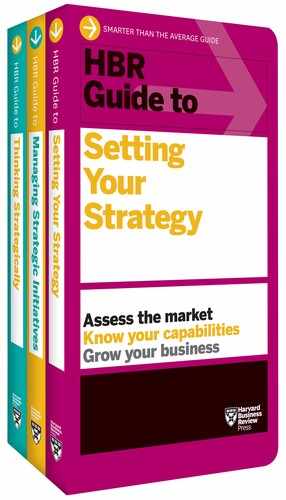Index
access-based positioning, 274
actions
aligning with strategy, 195–203
converting vision into, 188
alignment, 21–22, 195–203, 280–281
ambiguity, navigating, 251–257
anchoring bias, 86
Argyris, Chris, 246
assumptions, challenging, 16–18, 70, 86–87, 88, 161
biases, 70, 86, 114–115, 123, 148, 225
conflicting goals and, 157–158
current activities and, 175
external view of company and, 73–80
maintaining, 8
spotting trends and patterns, 61–71
bosses. See managers
brainstorming, 121
budget process, 208, 210, 224–225
career advancement, 33–34, 35, 38
caretaking, 102
change(s)
opportunities for, 263
rate of, 110
responding to, 217
root causes of, 63
choices, reflecting on your, 109–112
Christensen, Clayton, 275, 278
Clinton, Bill, 105
close-in perspective, 93–97, 104
cognitive biases, 70, 86, 114–115, 123, 148, 225
communication
with teams, 255
companies. See organizations
competitive advantage, 43, 79, 88, 242–243, 272–275, 279
confirmation bias, 123
consensus, 149
contingency if-then plans, 228–229
contributions, 136
corporate vision. See vision
critical priorities, 128–129, 131
cross-functional collaboration, 201, 211
cultural factors, in success, 215–217
curiosity, 6
customers, listening to, 75, 78–79
data
collection, 201
confirmation bias and, 123
detecting patterns in, 68
sharing, 201
“data DIET” decision making approach, 120–123
decision making
aligning with strategy, 265–266
close-in perspective and, 93–97
following up on, 117
history of, 114
with organization in mind, 8–9
pros-and-cons lists for, 114, 164–165
reflexive, 110
uncertainty and, 6
zooming out perspective and, 97–100
department needs, vs. company needs, 167–168
design thinking, 122
developmental networks, 56
DIET. See “data DIET” decision making approach
differentiation, 207–208, 273–274
driving forces, 278
emotions
acknowledging, 255
navigating, 255
employees. See also team members
conflicting messages to, 245–249
high-impact, 199
relationship-driven approach to, 206–207
enterprise software, 115
ethical concerns, 241
execution. See strategy execution
external forces, affecting organizations, 64–67
external risks, 47
failures, learning from, 22–24
“five whys,” 17
Ford, Henry, 86
Franklin, Benjamin, 114
future
focus, 6
predictions about, 56–57, 89–90, 179–180, 253
shaping the, 217
“garbage can” decision making, 120, 122
goals. See also strategic goals and objectives
letting go of outdated, 143–154
organizational, 9, 150–151, 221–234
Gollwitzer, Peter, 223
Google, 88
habits, 223
Henderson, Bruce, 272
high-impact people, 199
high-performing teams, 214–219
Hill, Linda A., 55–58, 238, 239, 241
humor, 246
Ibarra, Herminia, 101
IBM, 103
ideas, 111
if-then statements, 121
important priorities, 129
incapacity, 101
categorizing into themes, 68
detecting patterns in, 68
missing, 116
information overload, 136, 231
internal resources and capabilities, 277–278
internal risks, 47
interviews, with stakeholders, 78–79
Jobs, Steve, 208
Kahneman, Daniel, 114, 179–180, 228
Keynes, John Maynard, 100
KJ diagrams, 122
knowledge, breadth of, 7
layoffs, 82
leaders. See leadership
development, 103
gender differences in, 101–102
21st-century, 101
learning, from failures, 22–24
legacy work, 174
letting go, aversion to, 144–148
listening, to customers, 75, 78–79
logical decision making, 144–145
long-term thinking, 81–84, 85, 98
as communicators, 281
conflicting messages from, 245–249
gender differences in, 101–102
tapping into expertise of other, 255–257
March, James G., 120
McDonald, Robert, 98
McKeown, Greg, 140
messages, conflicting, 245–249
mission statements, 52
motivation, of employees, 208–209, 211
narrative fallacy, 180
need-based positioning, 273
needs, company vs. department, 167–168
networks
developmental, 56
trend spotting and, 65
Novartis, 102
novelties, 99
Obama, Barack, 100
objectives, 128. See also strategic goals and objectives
openness, 7
operational processes, 31
opportunities, 13, 15, 148, 263, 276–277, 278
opportunity costs, 145–146, 149
organizational goals. See also strategic goals and objectives
aligning team around, 9
organizational identity, 214–215
organizational learning, 22–24
organizational strategy. See strategy
external forces affecting, 64–67
purpose of, 262
strategic objectives of. See strategic goals and objectives
organizing framework, for priorities, 137–140
outdated objectives, letting go of, 143–154
outward focus, 6
passion, 137
past successes, letting go of, 144–148
personal board of directors, 239
perspective. See also big-picture perspective
conflicting, 136
flagging in calendar, 140
important, 129
legacy, 174
managing trade-offs for, 163–169
organizing framework for, 137–140
resource allocation for, 130–134
setting, 9, 127–134, 135–141, 216–217, 266–267
spreadsheet for, 132
taking ownership of, 136
problem-finding mindset, 121
projects
individual, 151
legacy, 174
process for winnowing, 150–154
pros-and-cons lists, 114, 164–165
questioning
asking big questions, 70
fundamental beliefs of organization, 87–88
by strategic thinkers, 7
rank ordering, of priorities, 127–128, 134
rational choice theory, 114
real costs, 145
relationships
strategic, 111
research, 65
resources
allocation of, 130–134, 143–144, 221
cutting objectives and reallocating, 151–152
redirecting, 176
rigidity, 28
ripple effects, 69
Rothschild, Nathan, 13
“safe zone” meetings, 17
scenario planning, 16, 180–183
Schiemann, William, 5
self-reflection, 97
senior leaders, strategic thinking by, 4
short-term expectations, 81–84
short-term strategies, 253–254
The Social Network, 99
stakeholders
identifying internal and external, 22, 262–263
influencing, 217
status quo
bias for, 148
Strategic Aptitude Self-Assessment, 22–24, 25–26
strategic goals and objectives
aligning decisions with, 265–266
information gathering on, 44–46
letting go of outdated, 143–154
sequencing, 159
strategic leadership, 7, 13–26, 173–177
strategic priorities. See priorities
strategic relationships, 111
strategic vision. See vision
activities to support, 279–280
communication of, 196
defining, 214
execution. See strategy execution
link between execution and, 205–212
risks of, 261
translating into everyday processes, 210, 215
understanding organization’s, 8, 43–49, 260–261
strategy execution, 9–10, 156, 158–161
overcoming obstacles to, 223–225
by teams, 213–219, 221–234, 267–268
strategy statements, 52
stress, 136
subgoals, 231
Summers, Lawrence, 99
tasks
communication with, 255
teams
aligning around organizational goals, 9
communicating vision to, 185–191, 269
evaluating success of, 175–176
if-then planning with, 225–233
strategic leadership of, 173–177
strategy execution by, 213–219, 221–234, 267–268
technology, 115
thinking
design, 122
strategic. See strategic thinking
threats
prioritizing, 278
time, for strategic thinking, 36–37
to-do lists, 151, 152, 153, 154, 221–222
Toyoda, Sakichi, 17
trade-offs, 9, 127, 145, 163–169, 266–267
trends
Tversky, Amos, 228
uncertainty, 6, 47, 85, 251–257
unexpected situations, planning for, 228–229
variety-based positioning, 273
Vasella, Daniel, 102
Veblen, Thorstein, 101
converting to action, 188
emphasizing benefits of, 188–189
strategic, 83
Walmart, 273
workload
balancing both perspectives, 101–105
Zuckerberg, Mark, 99
